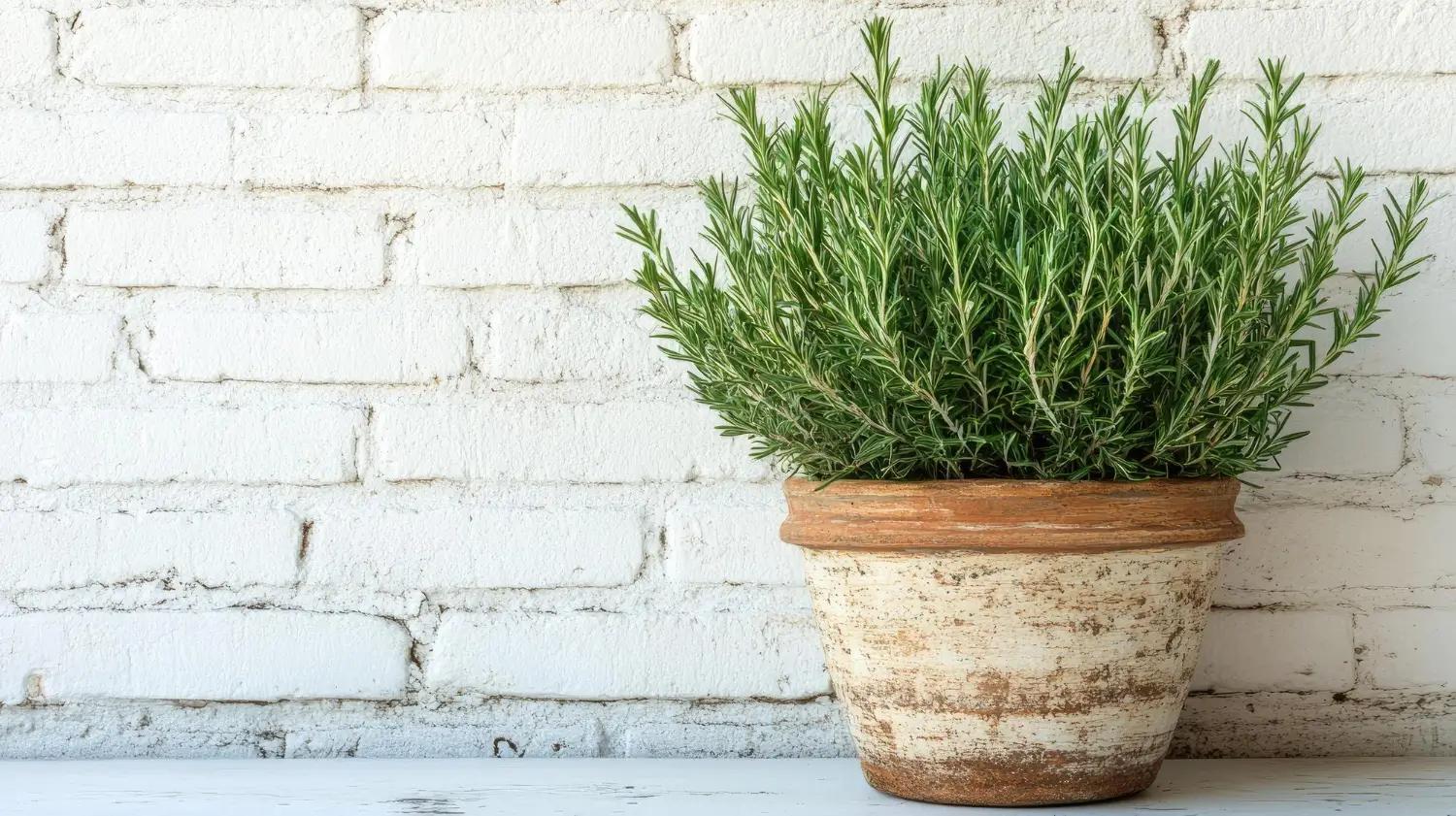
August 24, 2025

Fresh herbs can add flavor and aroma to meals, making them an important part of home cooking. However, store-bought herbs often lose their freshness quickly, which can affect food taste. Rosemary is tough to find fresh in stores, particularly during certain seasons. Many common herbs, like basil and parsley, are delicate and need special care to grow, making them less reliable for year-round use. This is where growing rosemary at home becomes a great solution.
Rosemary is a strong, hardy herb that grows well in many environments. It is also easy to grow and stays fresh longer than many other herbs. This evergreen herb comes from the Mediterranean region. It is known for its fragrant leaves, which are commonly used in cooking, especially Mediterranean dishes.
Growcycle provides high-quality rosemary seeds suitable for both small and large scale gardening projects. It also offers specialized planters like the Verandah 9x7 Rosemary Bonsai Jade. These self-watering ceramic planters are designed to support healthy plant growth by maintaining optimal moisture levels, making them ideal for cultivating rosemary.
Rosemary, scientifically known as Rosmarinus officinalis, is an evergreen shrub in the mint family (Lamiaceae). It is native to the Mediterranean region and thrives in warm, sunny climates.
Rosemary is a woody perennial plant that typically grows to a height of 3 to 5 feet (1 to 1.5 meters) and can spread about 4 feet (1.2 meters) wide. The plant has a bushy, upright growth habit, though some varieties may trail or spread along the ground. Its leaves are narrow, linear, and aromatic, giving off a strong scent when crushed or brushed. Rosemary often has a dense, compact form, especially when pruned.
The rosemary leaves are slender, lance-shaped, and dark green on top with a lighter, silvery underside. They are typically 1 to 2 inches (2.5 to 5 cm) long and have a leathery texture. The leaves are rich in essential oils, which contribute to the plant's strong fragrance and flavor. The oils also contain compounds like rosmarinic acid, camphor, and cineole, which have medicinal and aromatic properties.
Rosemary produces small, blue to purple flowers that appear in spring and early summer. The flowers are tubular, about 0.5 inches (1.2 cm) long, and grow in clusters at the tips of the branches. The flowers attract pollinators, especially bees, making rosemary beneficial for local ecosystems. The plant blooms in cooler months, providing both a source of nectar for pollinators and a pleasant visual display.
Rosemary has a strong, deep root system that helps the plant tolerate drought conditions. The roots grow long and spread out, making it well-suited for well-draining soils. Rosemary can be grown in containers or directly in the ground, where its roots can be established firmly.
Growing rosemary at home is a smart choice for anyone who enjoys fresh, flavorful herbs. It is a versatile plant that can be used in cooking, for health benefits, and even in beauty products.
Rosemary is a great herb to have in the kitchen because it makes food taste better. It adds a strong, fresh flavor to many dishes. It is often used to cook meats like chicken, lamb, and beef and vegetables like potatoes and tomatoes. Rosemary is also great for soups, stews, and marinades. Fresh rosemary gives food a strong taste, while dried rosemary is suitable for making tea, infusions, and even some desserts like cakes and cookies.
Rosemary is not only good for cooking; it also has many health benefits. The herb contains antioxidants and other compounds that can improve health in several ways:
Rosemary is a valuable herb for more than just cooking:
Growing rosemary at home is good for the environment. When people grow their own herbs, they don’t need to buy them from the store, which reduces waste and the need for plastic packaging. It also lowers the carbon footprint since the herbs don’t have to be shipped from far away. Growing rosemary helps protect the environment by supporting pollinators like bees and butterflies, which are important for a healthy ecosystem.
To grow rosemary successfully, it is important to understand the plant's ideal conditions. Here are the key factors to growing rosemary at home:
Rosemary thrives in warm, Mediterranean-like climates, where it enjoys plenty of sunlight and dry, well-drained soil. It is well-suited to regions with mild winters and hot, dry summers.
However, rosemary can also be successfully grown indoors, providing adequate light. This allows the plant to survive year-round in colder climates and ensures a fresh supply of leaves even in the winter months.
Rosemary loves sunlight and requires at least 6 to 8 hours of direct sunlight each day. If grown outdoors, rosemary should be planted in a location with full sun, such as a sunny garden bed or a raised container that receives consistent exposure to sunlight.
It is ideal to grow rosemary indoors near a south or west facing window. If natural light is insufficient, especially during the winter months, a grow light can help the plant thrive.
Rosemary prefers well-draining soil, as it does not tolerate waterlogged conditions. For ground planting, sandy or loamy soil with good drainage is best. In containers, a potting mix designed for succulents or cacti is ideal, as these types of mixes provide the drainage needed to prevent root rot.
Adding perlite or coarse sand to regular potting soil can also improve drainage and create an environment miming rosemary’s natural habitat.
Rosemary grows best in temperatures between 60°F to 75°F (15°C to 24°C). It can tolerate heat but is sensitive to frost. In regions with freezing winters, bringing the plant indoors or protecting it from cold temperatures is important.
It prefers low to moderate humidity and can struggle in overly humid environments. Avoid misting or placing the plant in very damp areas to keep it happy. If grown indoors, ensure proper ventilation to prevent humidity buildup.
Rosemary can be grown both from seeds or cuttings. Here is a step-by-step guide to planting rosemary at home:
Rosemary is a hardy and low-maintenance herb that still needs some care to thrive. Here is how to care for rosemary plants effectively:
Rosemary is drought-tolerant and doesn’t need frequent watering. In fact, it prefers dry conditions and should not be overwatered. The best way to know when to water rosemary is to check the soil. When the top 1-2 inches of soil feels dry, it’s time to water. Water the plant deeply, allowing the water to reach the roots. However, it’s important not to let the plant sit in water, as this can lead to root rot.
Signs of overwatering include yellowing leaves, wilting, and a soggy soil surface. Underwatering is shown by dry, crispy leaves that may curl or drop off. If this happens, water the plant thoroughly and try to keep a consistent watering schedule, allowing the soil to dry out between waterings.
Rosemary doesn’t need much fertilizer, but applying some can promote healthy growth, especially in a container. Use a balanced, slow-release fertilizer or a liquid fertilizer with equal parts nitrogen, phosphorus, and potassium. Apply fertilizer in the spring when the plant begins its active growing season and again in mid-summer if needed. Avoid over-fertilizing, as this can cause the plant to become leggy and lose its flavor.
Using a fertilizer specifically designed for herbs or Mediterranean plants can benefit container grown rosemary. It is best to fertilize once or twice a year, as rosemary thrives in lean soil and does not need heavy feeding.
Pruning rosemary helps to keep the plant healthy, encourages new growth, and prevents it from becoming too woody or overgrown. Trim rosemary plants regularly to maintain their shape and size. Use sharp scissors or pruning shears to remove the tips of the stems. If necessary, growers can prune back about one-third of the plant but avoid cutting into the woody part of the stem, as this can damage the plant.
Pruning also encourages bushier growth and helps the plant maintain its compact shape. Regular pruning is key to keeping rosemary tidy and manageable if people grow it as a hedge or topiary.
Rosemary is generally resistant to pests, but sometimes it can attract a few common garden insects. The most common pests that affect rosemary are aphids, spider mites, and whiteflies. To deal with these pests, gently wash the leaves with a stream of water or use insecticidal soap to treat the plant.
To prevent pests, rosemary needs good air circulation, especially if grown indoors. Excessive moisture around the plant can invite pests, so avoiding excessive moisture is important. Also, regularly inspect the plant for signs of damage, such as sticky residue (which indicates aphids) or webbing (which indicates spider mites).
If rosemary is grown in a container, it may need to be repotted every 1-2 years. Signs that it’s time to repot include the roots growing out of the drainage holes or the plant becoming too large for the pot. When repotting, choose a slightly larger container and ensure it has good drainage.
To repot rosemary, gently remove it from its old pot and loosen the roots. Then, place the plant in the new pot and add fresh, well-draining soil around it. After repotting, water the plant thoroughly and keep it in a sunny spot to help it settle into its new container.
Rosemary can be harvested once the plant is established and has enough foliage to sustain it. Before taking any leaves, wait until the plant is at least 6-8 inches tall. The best time to harvest rosemary is during the growing season, typically in spring and summer when the plant is actively growing.
To harvest rosemary, it is essential to use proper techniques to avoid damaging the plant. Follow these steps:
The best time to harvest rosemary is in the morning, shortly after the dew has dried. This is when the plant’s essential oils, which give rosemary its strong aroma and flavor, are most concentrated. The oils tend to be at their peak in the morning, so harvesting during this time will give the best flavor and fragrance.
Growing rosemary at home is an easy and useful way to have fresh herbs all year. It can improve food taste, support digestion, or even make beauty products. Its pleasant smell and air-purifying qualities make it a great plant for indoor spaces.
By following simple planting and care instructions, anyone can enjoy its many benefits while reducing the cost of buying herbs and packaging. Explore the Growcycle marketplace to find the best gardening tools and tips for growing rosemary plants successfully.
Disclaimer: This material is for informational purposes only and should not be relied on for legal, medical, financial, or any other form of professional advice.
Harvesting only one-third of the plant at a time to keep rosemary growing and cut above a set of leaves or branches. This encourages new growth and prevents damage to the plant.
Both methods work well, but drying rosemary preserves its flavor longer. Freezing is a good option for short-term use and helps maintain the herb’s freshness.
Trim rosemary by cutting sprigs from the top or side of the plant, leaving enough foliage for growth. Always avoid cutting too much from the woody base to allow new growth.